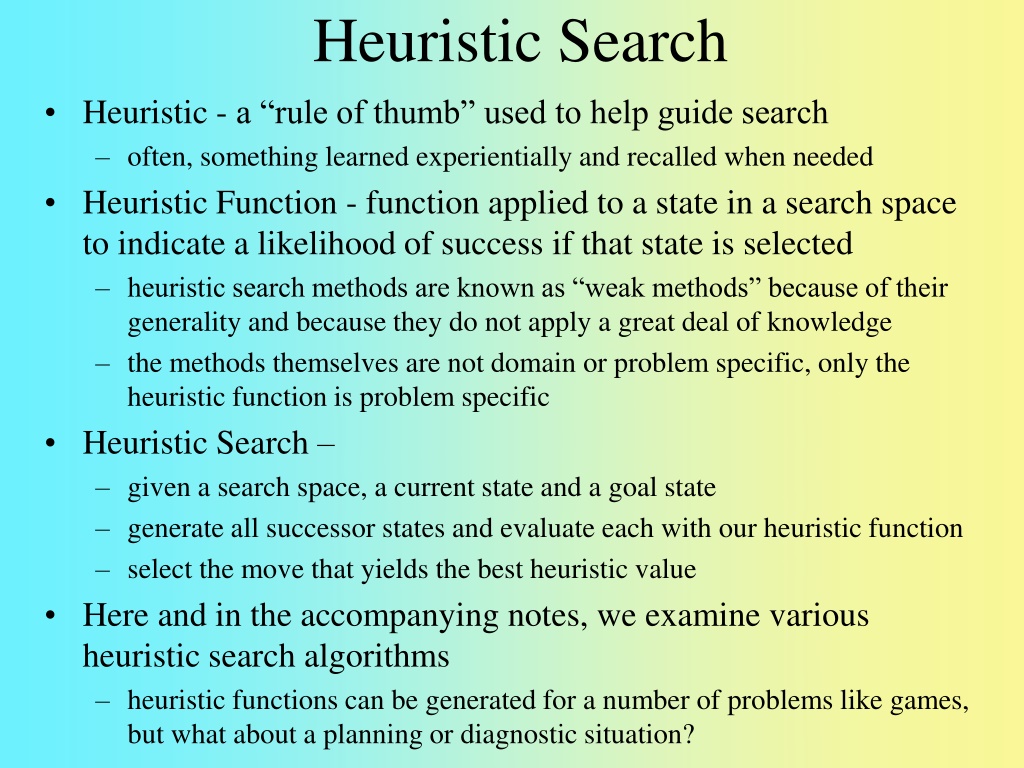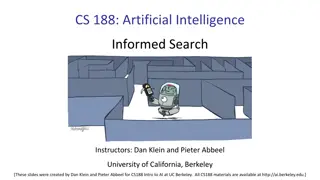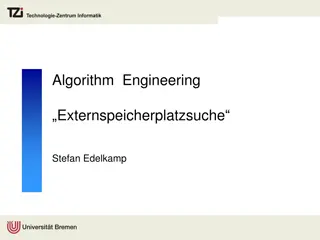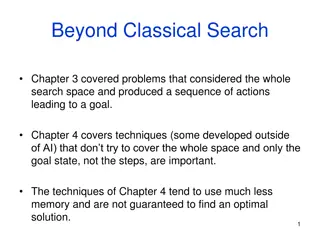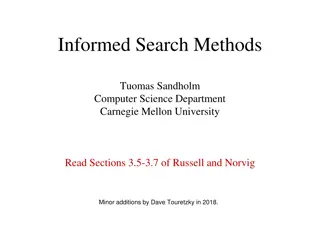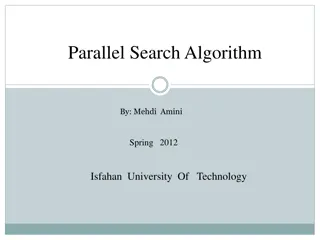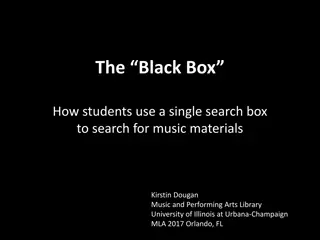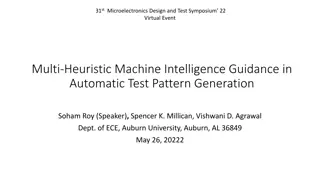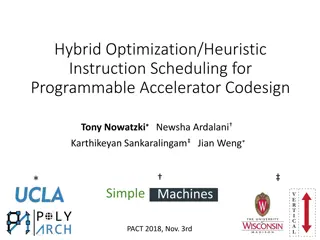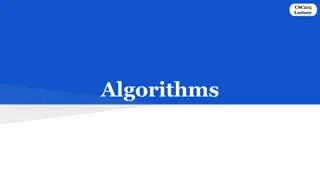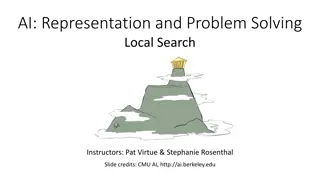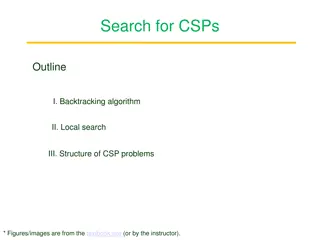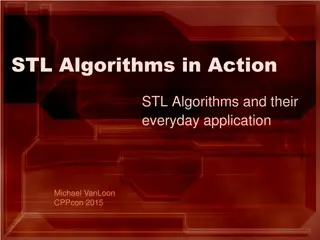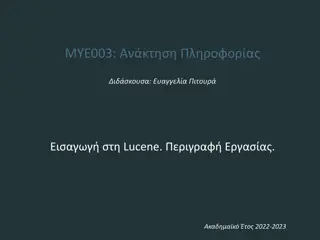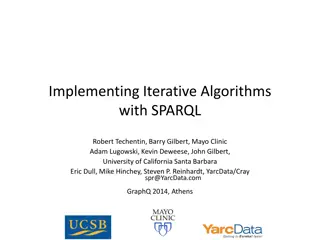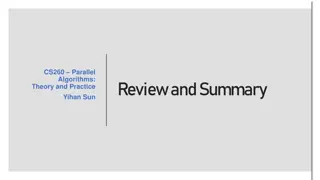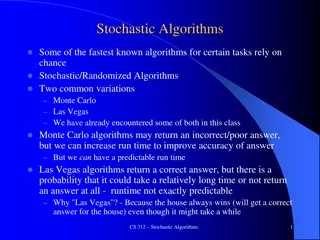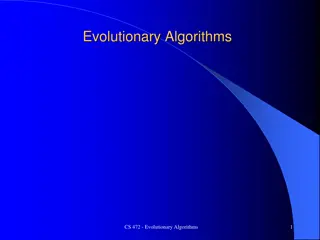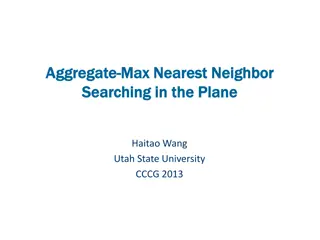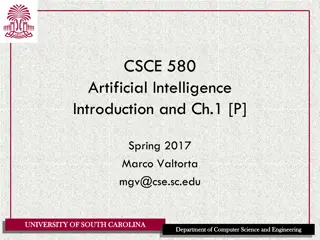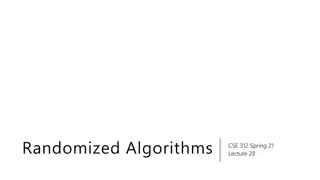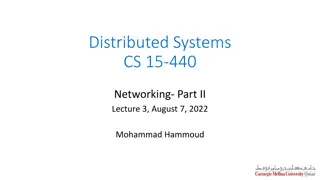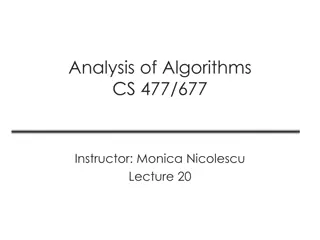Understanding Heuristic Search Algorithms in AI
Heuristic search involves using rules of thumb to guide search algorithms by assessing the likelihood of success based on a heuristic function. This method helps determine the best move or state to pursue towards a specific goal. The concept of heuristic search is explored, along with examples of heuristic functions for problems like the 8-puzzle, highlighting the importance of differentiating between local and global heuristics.
Download Presentation

Please find below an Image/Link to download the presentation.
The content on the website is provided AS IS for your information and personal use only. It may not be sold, licensed, or shared on other websites without obtaining consent from the author. Download presentation by click this link. If you encounter any issues during the download, it is possible that the publisher has removed the file from their server.
E N D
Presentation Transcript
Heuristic Search Heuristic - a rule of thumb used to help guide search often, something learned experientially and recalled when needed Heuristic Function - function applied to a state in a search space to indicate a likelihood of success if that state is selected heuristic search methods are known as weak methods because of their generality and because they do not apply a great deal of knowledge the methods themselves are not domain or problem specific, only the heuristic function is problem specific Heuristic Search given a search space, a current state and a goal state generate all successor states and evaluate each with our heuristic function select the move that yields the best heuristic value Here and in the accompanying notes, we examine various heuristic search algorithms heuristic functions can be generated for a number of problems like games, but what about a planning or diagnostic situation?
Example Heuristic Function Simple heuristic for 8-puzzle: add 1 point for each tile in the right location subtract 1 point for each tile in the wrong location Better heuristic for 8-puzzle add 1 point for each tile in the right location subtract 1 point for each move to get a tile to the right location The first heuristic only takes into account the local tile position it doesn t consider such factors as groups of tiles in proper position we might differentiate between the two types of heuristics as local vs global Goal: Current: Moves: 7 down (simple: -5, better: -8) 6 right (simple: -5, better: -8) 8 left (simple: -3, better: -7) 1 4 7 8 2 3 5 6 4 2 3 5 7 1 6 8
Example Heuristics: 8 Puzzle From the start state, which operator do we select (which state do we move into)? The first two heuristics would recommend the middle choice (in this case, we want the lowest heuristic value) while the third heuristic tells us nothing useful (at this point because too much of the puzzle is not yet solved)
Hill Climbing Visualize the search space as a 3-dimensional space a state is located at position <x, y> where these values represent the state s variables, and its z value (height) is its heuristic worth this creates a topology where you want to reach the highest point in actuality, most problems have states that have more than just <x, y> values so in fact, hill climbing takes place in some n+1 dimensions where n is the number of variables that define the state and the last value is the heuristic value, again, indicated as height to solve a problem, pick a next state that moves you uphill Given an initial state perform the following until you reach a goal state or a deadend generate all successor states evaluate each state with the heuristic function move to the state that is highest This algorithm only tries to improve during each selection, but not find the best solution
Variations of Hill Climbing In simple hill climbing, generate and evaluate states until you find one with a higher value, then immediately move on to it In steepest ascent hill climbing, generate all successor states, evaluate them, and then move to the highest value available (as long as it is greater than the current value) in both of these, you can get stuck in a local maxima but not reach a global maxima Another idea is simulated annealing the idea is that early in the search, we haven t invested much yet, so we can make some downhill moves in the 8 puzzle, we have to be willing to mess up part of the solution to move other tiles into better positions the heuristic worth of each state is multiplied by a probability and the probability becomes more stable as time goes on simulated annealing is actually applied to neural networks Note: we are skipping dynamic programming, a topic more appropriate for 464/564
Best-first search Below, after exploring A s children, we select D. But E and F are not better than B, so next we select B, followed by G. One problem with hill climbing is that you are throwing out old states when you move uphill and yet some of those old states may wind up being better than a few uphill moves the best-first search algorithm uses two sets open nodes (those generated but not yet selected) closed nodes (already selected) start with Open containing the initial state while current <> goal and there are nodes left in Open do set current = best node* in Open and move current to Closed generate current s successors add successors to Open if they are not already in Open or Closed Closed A (5) B (4) C (3) D (6) G (6) H (4) E (2) F (3) Open I (3) J (8) - this requires searching through the list of Open nodes, or using a priority queue Now, our possible choices are I, J, H, E and F
Best-First Search Algorithm
Best-first Search Example
Heuristic Search and Cost Consider in any search problem there are several different considerations regarding how good a solution is does it solve the problem adequately? how much time does it take to find the solution (computational cost)? how much effort does the solution take? (practical cost) notice that the second and third considerations may be the same, but not always It will often be the case that we want to factor in the length of the path of our search as part of our selection strategy we enhance our selection mechanism from finding the highest heuristic value to finding the best value f(n) = g(n) + h(n) f(n) cost of selecting state n g(n) cost of reaching state n from the start state h(n) heuristic value for state n if we use this revised selection mechanism in our best-first search algorithm, it is called the the A Algorithm Since we want to minimize f(n), we will change our heuristic functions to give smaller values for better states some of our previous functions gave higher scores for better states
Other Factors in Heuristic Search Admissibility if the search algorithm is guaranteed to find a minimal path solution (if one exists) that is, minimize practical cost, not search cost a breadth-first search will find one if our A Algorithm guarantees admissibility, it is known as an A* Algorithm with the selection formula f*(n) = g*(n) + h*(n) where g*(n) is the shortest path to reach n and h*(n) is the cost of finding a solution from n h(n) is an estimated cost derived by a heuristic function, h*(n) may not be possible, it requires an oracle Informedness a way to compare two or more heuristics if one heuristic always gives you a more accurate prediction in the A* algorithm, then that heuristic is more informed Monotonicity we will skip this there are other search strategies covered in the notes accompanying this chapter
Constraint Satisfaction Many branches of a search space can be ruled out by applying constraints Constraint satisfaction is a form of best- first search where constraints are applied to eliminate branches consider the Cryptorithmetic problem, we can rule out several possibilities for some of the letters After making a decision, propagate any new constraints that come into existence constraint Satisfaction can also be applied to planning where a certain partial plan may exceed specified constraints and so can be eliminated SEND + MORE MONEY M = 1 S = 8 or 9 O = 0 or 1 O = 0 N = E + 1 (since N != E) Now we might try an exhaustive search from here
